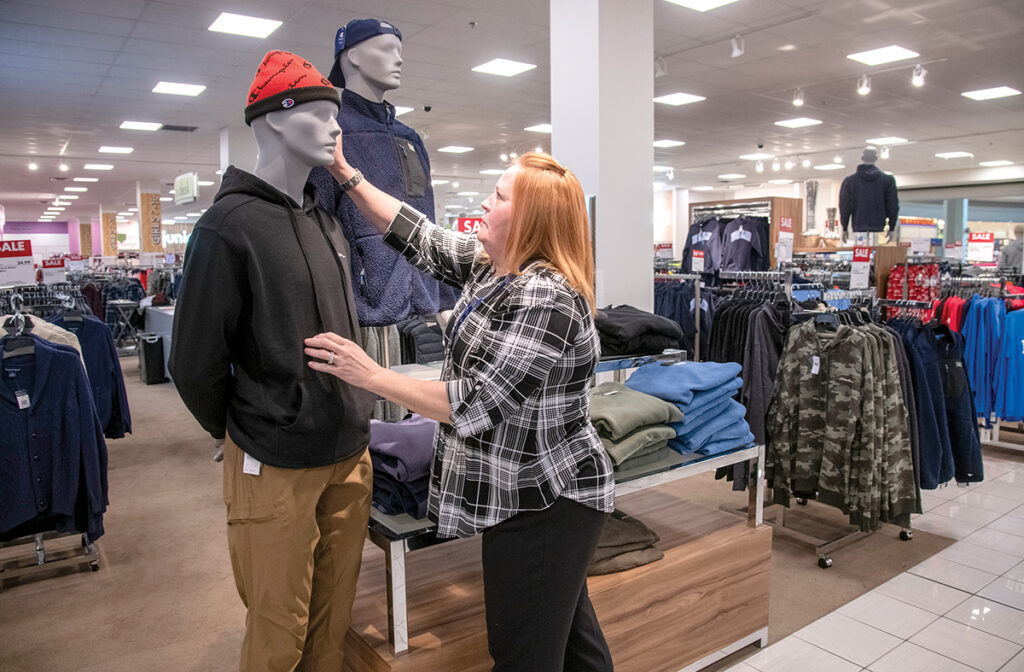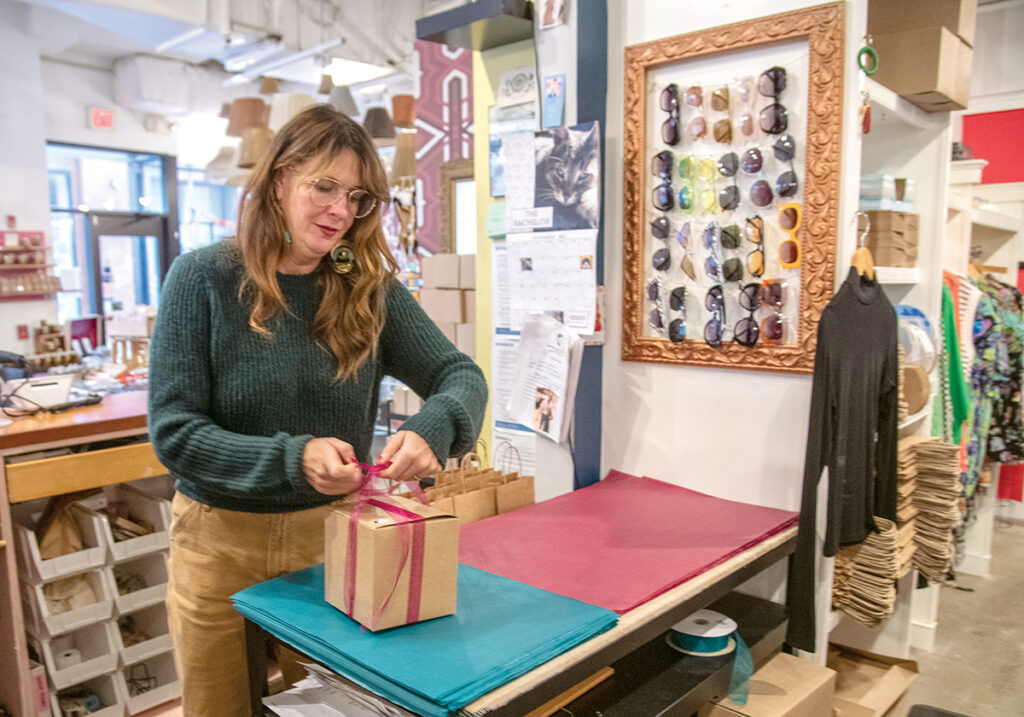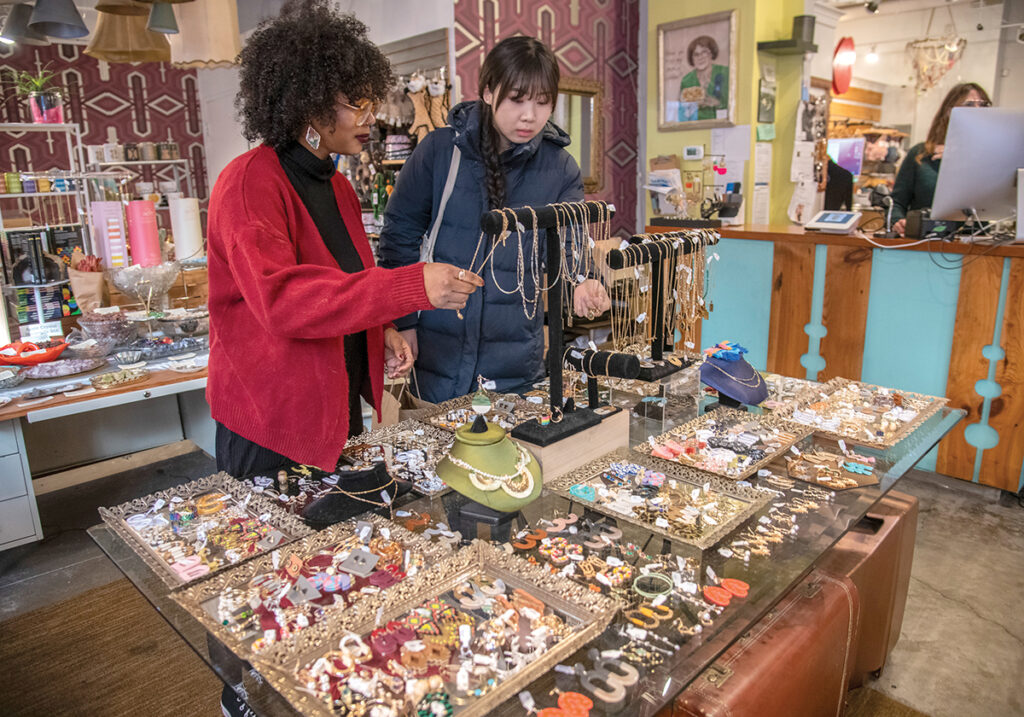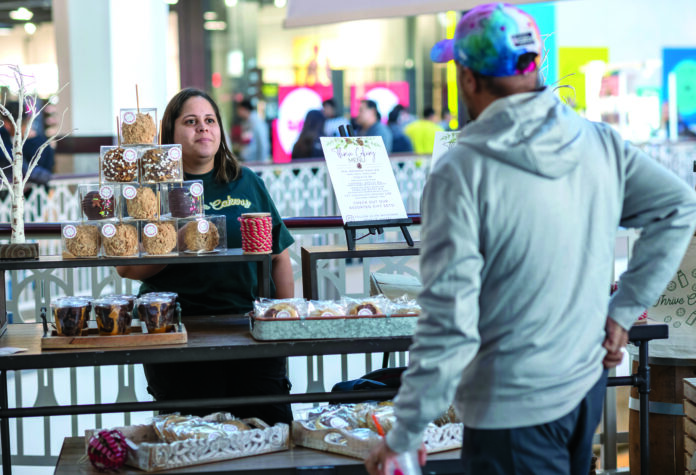Karen Beebe’s Christmas season began months ago, in the heat of August, when she placed an order for 360 holiday ornaments.
For Beebe, the owner of the Providence boutique Queen of Hearts LLC on Westminster Street, the decorations had been popular among her customers over the years, and she was looking to avoid the disappointment that had happened a year earlier.
That’s when the shipment of ornaments got entangled in the global supply chain mess. The merchandise showed up in late December, at a time when much of the Christmas shopping rush had passed.
This year, the ornaments were delivered in September.
Crisis averted. But for Beebe and other retailers large and small, the uncertainties about the Christmas shopping season and beyond are continuing to cause some headaches and handwringing.
Indeed, in many ways, this holiday shopping season has been unlike any other, situated amid a fading COVID-19 pandemic and the growing rumbles of an economic recession, making it difficult to make dependable forecasts about the spending appetite of shoppers.
Adding to the uncertainty: whether consumers would mostly shop online or in person, in a yearning for normalcy after nearly three years of pandemic precautions.
It has all led to wild swings in the confidence levels of merchants.
The challenges cropped up long before the season arrived. Not wanting to get burned by supply chain issues again this year, many retailers placed orders much earlier and then received backlogged orders that had been held up by manufacturing and shipping delays, leaving stores with heaping piles of merchandise.
“Many retailers now have the opposite problem, where they might be overstocked,” said Lauren Labrecque, a marketing professor at the University of Rhode Island.
And just as stores were holding an excess of inventory, surging inflation and higher fuel costs had shoppers tightening their purse strings, particularly on goods such as clothing, electronics and furniture.
To rid themselves of the extra inventory, many large retailers started the sales more than a month before Black Friday, the traditional start of the holiday shopping season.
But while clearing warehouses of stockpiles and making room for Christmas orders, those discounts threaten to cut into profits and dampen the desire of shoppers to hand over more dollars later in the year.
Jim Boscov isn’t sounding worried that any of this will change the bottom line: people want to shop during the holiday season.
Boscov is chairman and CEO of Boscov’s Inc., a Pennsylvania-based, family-owned department store chain with 49 locations, including a three-floor anchor store at Providence Place mall, and he’s predicting a busy December.
“Our buyers worked very hard to make sure that all the inventory came in early so that everything we need between now and the end of the year [is] either in the store or warehouse,” Boscov said. “Christmas and the holidays are something special. People go out of the way to make sure they give the gifts they want to give.”
[caption id="attachment_424845" align="aligncenter" width="1024"]

STRAIGHTEN UP: Maryann McCann, assistant manager of the men’s department at Boscov’s Inc. in the Providence Place mall, straightens up a mannequin display.
PBN PHOTO/MICHAEL SALERNO[/caption]
ENCOURAGING SIGNS
Certainly, Boscov has been buoyed by the early sales figures.
Many shoppers did not hesitate to take advantage of October discounts, as retail and food services sales in that month were up 1.3% from September and 8.3% from October 2021, according to data from the U.S. Department of Commerce. And holiday retail sales during November and December are expected to grow between 6% and 8% over 2021 to between $942.6 billion and $960.4 billion, according to a forecast by the National Retail Federation.
So far, stores are beating that projection.
Overall, national retail sales on Black Friday rose 12% compared with the same day a year ago, according to Mastercard SpendingPulse. In-store sales increased by 12% and online sales by 14%, the report said. Adobe Analytics estimated that a record $9.1 billion was spent on Black Friday online sales, up from $8.9 billion in 2021, while consumers spent $11.3 billion online on Cyber Monday, 5.8% more than last year.
“Shopping power has declined because of inflation but the desire to shop is high,” said Farbod Farhadi, associate professor of business management at Roger Williams University. “We knew consumers were not going to let recession and pandemic overshadow their plans.”
Seeing the crowds flock to the stores early on has left operators of local malls and shopping centers with a merry feeling.
The Warwick Mall says the number of shoppers in the mall has rivaled turnout from years before COVID-19.
“While I expected it to be busy, I did not expect it to turn out the way it [has],” said Domenic Schiavone, general manager of Warwick Mall LLC.
Still, Labrecque says the inventory issues at the big-box stores have presented challenges for independent shops that don’t have the buying power or the ability to weather a whittling away of profit margins.
“For bigger retailers, it makes sense to move the stock soon, and small retailers have to compete with these sales,” Labrecque said. “It will probably hurt small retailers.”
Beebe agrees.
[caption id="attachment_424846" align="aligncenter" width="1024"]

LITTLE THINGS: Karen Beebe, owner of Queen of Hearts LLC, a fashion boutique in downtown Providence, says one of the reasons people enjoy going to small businesses is for “little special things” such as complimentary gift wrapping.
PBN PHOTO/MICHAEL SALERNO[/caption]
She watched as big retailers offered steep discounts earlier in the fall, gobbling up shopping dollars that might have found their way to small stores such as hers in December.
“It used to be a specific day when businesses highlight a sale and now [big-box] businesses are having three-weeklong Black Friday sales,” Beebe said.
Then things looked bleaker on Black Friday itself. “Terrible,” Beebe said in her assessment of sales that day, registering about the revenue the stores took on the same day a year earlier.
But the unpredictability of the 2022 holiday shopping season kicked in the next day, Small Business Saturday.
Beebe says it was a roaring success, with Queen of Hearts’ busiest day on record. Throughout Saturday, the store recorded 167 transactions, compared with 135 on the same day a year ago.
HUNTING FOR ‘NORMALCY’
While shopping online remains strong – Amazon.com Inc. touted record sales in a five-day period from Thanksgiving to Cyber Monday – there’s no doubt shoppers have returned to stores in full force.
“I think people are gravitating more to in-person shopping,” Labrecque said. “People have gotten accustomed to online shopping. But I think this year, we’ll see more people shopping in stores just to get back to sort of normality and that’s part of normalcy.”
That might explain why Providence Place Senior General Manager John Zilliken – who said foot traffic on Black Friday was up about 3% from last year – notes a shift in the vibe among shoppers this season.
“I think the sense of friends, family and community was very prominent,” Zilliken said. “There wasn’t a lot of individual shoppers … it was three or four people together, going to the store and carrying bags.”
Boscov says his stores are experiencing pre-pandemic shopping patterns, with higher numbers of in-store shoppers. Online sales only make up about 10% of his company’s sales.
Upscale Garden City Center in Cranston has been bustling, too. “I think our customers, especially after COVID, are just so eager to get out and shop and be able to spend time outside and be able to get together with their families,” said Faith Lockhart, Garden City marketing manager. “They’re not just shopping here: they’re going out to dinner, they’re coming out to our events.”
Jo Lee is looking to help small retailers to capitalize, particularly ones that exist only online.
Lee owns PopUp Rhody, a business incubator that matches those businesses with others that have available space where a shop and an event can be set up within the brick-and-mortar location.
She, too, suspects shoppers are eager to connect with others and are nostalgic for traditional holiday shopping.
“We all discovered how lonely [a] pure digital experience is,” Lee said. “Community and engagement and face-to-face conversation – that’s going to be the dominant spirit of this holiday season.”
That’s why Jasmine Mendez decided to “pop up” at Providence Place.
Mendez owns the Thrive Cakery LLC, a bakery she opened in 2021 that doesn’t have a brick-and-mortar location. Instead, she sets up a table at the Providence Flea and the farmers market at Farm Fresh Rhode Island in Providence.
This year, Thrive Cakery has set up a kiosk at the mall through the new year.
Located across from Starbucks Corp. on the second floor, Mendez said she is hoping to catch the attention of busy shoppers running in between stores and possibly gain some new loyal customers.
“I don’t know how much in-store shopping still has an appeal, but it is nice to get out,” Mendez said. “It could go either way, but I have high hopes that people will like to shop in person and browse around.”
Farhadi isn’t so sure an in-person shopping surge will be maintained come January. It’s all about convenience.
“Online shopping and deliveries will stay with us,” Farhadi said. “People that experienced contactless shopping will choose to continue to shop online. The majority of this is driven by the fact that people now value their time.”
[caption id="attachment_424843" align="aligncenter" width="1024"]

HELPING HAND: Jordynn Robinson, left, social media and e-commerce manager at Queen of Hearts LLC, a fashion boutique in downtown Providence, speaks with Yukyung Chung, a student at the Rhode Island School of Design.
PBN PHOTO/
MICHAEL SALERNO[/caption]
FACING REALITY?
Retailers should enjoy the moment while it lasts. Farhadi says economic realities will likely kick in next month, cooling shoppers’ desire to spend and shrinking profits.
While vendors were able to take a break from supply chain woes that plagued last year’s holiday shopping season, other challenges will loom for the rest of winter. Over the last year, prices have skyrocketed across the board, making retailers – especially small businesses – aware of the thinning profit margin.
Beebe said the cost of “everything” has risen, from wholesale products to labor costs. For example, some of the leather products Queen of Hearts buys increased by $10 per item, Beebe says.
“There really isn’t much that you can do to really make up for those costs except try to sell more stuff,” Beebe said.
One of the hardest-hit sectors has been food vendors. The prices of some kitchen staples have surged in 2022. Mendez says she used to pay 3 cents an egg, but now it can be as much as 25 cents. Butter, too, is much pricier.
Because she refused to modify her recipes with less-expensive ingredients, Mendez says she was forced to increase her prices by almost 25%.
“The holiday season … is when businesses, especially bakeries, start to go in the black,” Mendez said. “This year [businesses are] not as optimistic that [they’ll] be back in the black and that’s scary.”
In one way, there would be a potential benefit of inflation for small businesses during the holidays: Some retailers say they see shoppers choosing to be more “intentional” about where their money goes since the dollar can’t buy as much.
“I think our budget from Christmas is a bit smaller this year, but that’s why the purchases are going to be more meaningful,” Mendez said.
It might be just the edge a store such as Queen of Hearts needs.
“You just get a different experience, like complimentary gift wrapping and all those things,” Beebe said. “I think that’s one of the things that people really enjoy going to small business for, it’s those little special things.”
















